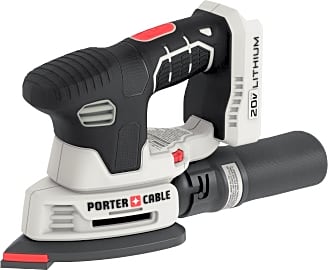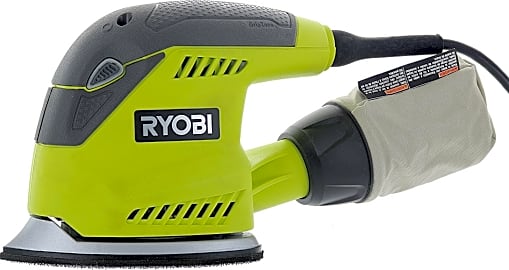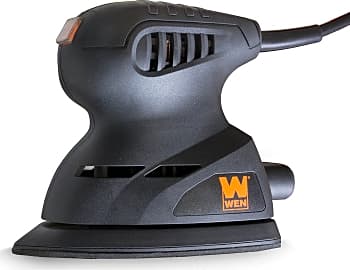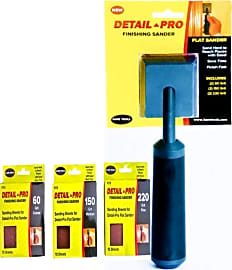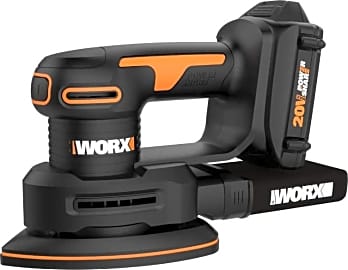The 10 Best Detail Sanders

This wiki has been updated 39 times since it was first published in July of 2015. When you want to finish off a woodworking project perfectly, you need the right tool for the job. One of these detail sanders will give you the fine, smooth surface you need before applying a finish, without the time and effort of hand sanding. They're specifically designed for both flat corner sanding, as well as getting into tight spaces, like in the joints of furniture or corners of molding. When users buy our independently chosen editorial selections, we may earn commissions to help fund the Wiki.
Editor's Notes
November 28, 2020:
For this update, we removed the Dobetter MS20 because it is currently unavailable, as well as the Skil SR232301 because of some reliability issues, and the fact that we had several other nearly identical models already on our list.
We added some design variety in the new options we added, like the WEN 6307, a slim file sander. Its design doesn't allow for the broad strokes of the typical mouse-style detail sanders you often see, but its narrow shape makes it perfect for accessing the hard to reach sides of smaller workpieces. Instead of having to totally disassemble wood banisters or furniture pieces, this machine can slide into narrow areas, where other sanders would be far too bulky to reach.
We also added the Kane Tools Detail-Pro, a manual option. Though it won't come close to the productivity of a power sander, this hand tool allows for precise pressure and application that only a hand tool can give. This would be especially useful for breaking the edges of a shelf or tabletop, that would only require one or two passes of sandpaper. A power sander, even a light-duty one, would take off far too much material, too quickly.
If you don't require the accuracy of a detail sander and are more interested in general flat sanding, one of these orbital sanders might be a better choice. They still require some practice to prevent over-sanding edges and corners, but once you get the hang of it, they're extremely valuable tools to have around.
If you have the space, you may want to consider a drum sander as well. These are expensive machines, but if you're looking to smooth a lot of large wood pieces, they could be a great investment.
July 11, 2019:
Detail sanders are most useful when prepping the corners of wooden furniture and structures. As such, they are typically not the sander that will accumulate the most hours. This is partly because of how superior a random-orbit sander is at creating better surfacing and at tackling greater surface area while having to use fewer sanding stages than orbital and sheet sanders.
Detail sanders do have their place and there is little question that the Festool DTS 400 is the best. It is made with excellent, impact-resistant plastics, the pad will last a lot longer and will stand up to the occasional bump into corners. The only complaint I can think of will probably be aimed at the ergonomics(I have no issue with them) but that'll come down to personal preference.
The non-professional can do well with with a Porter-Cable PCCW201B or a Skil SR232301. They are reasonably robust and, if you have already committed to the Porter-Cable battery platform, you'll probably have several of them on-hand (the Skil is corded so this is not relevant).
All power tools come with inherent dangers and should be used with care. With sanding tools, the greatest dangers come from inhaling too much sawdust or from inhaling lead while sanding old paint. Anyone sanding should use a respirator to minimize the inhalation of harmful contaminants.
The Abridged History Of Sanding
Silicon carbide sandpaper actually involves no sand whatsoever, but the word sand has remained the term of art nonetheless.
While the first mention of "sandpaper" dates to the 13th Century CE, human beings have been using abrasives for thousands of years. An abrasive is simply a material -- often a natural mineral such as rock or an organic compound such as a seashell -- that can be used to smooth and polish another surface when friction is applied. Sanding can help remove imperfections from wood, clay, stone, or other materials, making them more suitable for use as building materials, to make furnishings, decorative items, and more.
Purpose built sandpaper (the kind first referenced in writings dating to the 1200s) was initially made using ground shells, seeds, and sand that was affixed to sheets of parchment using naturally occurring gums sourced from tree resin. The process was laborious and rather costly, and thus sandpaper use was relegated to limited applications.
In the 19th Century, as the Industrial Revolution led to advancements in multiple fields, so too did it lead to the first mast produced paper-based abrasive. Glass paper was developed by a Londoner named John Oakey in 1833. It used a diminutive glass-like ceramic called frit that had myriad sharp edges and points and which could be readily bonded to paper using newly developed adhesives.
Glass paper remained in common use well into the 1900s, before the development of a silicon carbide compound finally replaced the fruit as the chosen abrasive for sanding. Silicon carbide sandpaper actually involves no sand whatsoever, but the word sand has remained the term of art nonetheless.
Just as the Industrial Revolution led to the first mass produced, cheap, effective sandpaper, so to would the era see the first powered mechanical sanding machine. The drum sander was patented in the 1880s and made the process of sanding wood easier than ever before. These large table-like devices used drums to rapidly rotate swathes of abrasive paper and were principally used for making furniture and for finishing lumber.
Throughout the first half of the 20th Century, various sanders were developed and perfected, with ever smaller tools providing adequate power and versatility for a range of uses. By the close of the century, sander technology had reached the levels still enjoyed today, though occasional improvements are still seen, usually in facets such as enhanced speed control and vibration reduction.
The Detail Sander At Work
If you are considering a detail sander, then chances are good that you are a professional craftsman or at least a skilled and experienced Do It Yourself enthusiast. Therefore you know that these tools are not suitable for many types of work such as would be adroitly handled by an orbital sander or belt sander.
Certain detail sanders can be affixed with myriad plates allowing them to serve as grinders or cutting tools.
A detail sander has little business preparing a door or a table for painting or staining, for example, and it has no business whatsoever sanding down an entire floor prior to refinishing. However a detail sander used in tandem with these other, larger tools can lead to efficient, quality work.
Detail sanders were first seen in wide use in the 1990s, and were a welcome addition to the woodworker's tool chest. A good detail sander can take the place of sandpaper painstakingly used by hand thanks to its ability to get into those tight places a larger sander could never reach. Detail sanders are great for finishing corners or the portion of flooring next to a wall, and are priceless for work preparing or refinishing surfaces such as those of staircases or banisters, window sills and frames, or for wooden moulding.
Mosts detail sanders allow for deft control, so they are safe to use on sensitive surfaces such as antique woods, or to use on or near carefully crafted items such as carved and decorative wooden furnishings.
Many detail sanders are also in fact multitools, capable of much more than simply sanding precise areas of wood. Certain detail sanders can be affixed with myriad plates allowing them to serve as grinders or cutting tools. They can be used to cut through tile and grout, perfect for updating a bathroom, for example, or even to slice through metals or hard plastics, perfect for cutting away extra piping under a sink or bathtub, for example.
Choosing A Sander For The Artisan
The dedicated and demanding woodworker simply must own a detail sander if he or she wants to create high quality works efficiently. Many detail sanders are small enough to be handled almost like a pen (or paintbrush), applying abrasion with nearly surgical precision. Whether you are doing detail work on a miniature ship destined for a bottle or you are refinishing an irreplaceable piece of antique Mission style furniture, a detail sander ensures that you will have maximum control over your project.
Good detail sanders can accommodate many different attachments (often called shanks) and, when paired with sandpaper of the right grit, can be surprisingly powerful. Many detail sanders can easily achieve up 14,000 orbits per minute (often abbreviated to OPM) under moderate load, so they concentrate plenty of pressure where ever you want it. This allows you to work quickly without sacrificing precision.
Make sure to frequently change sandpaper when you are performing sensitive woodworking tasks, as the quality of your work is directly effected by the condition of the sandpaper you're using. Sandpaper is cheap and should be considered highly disposable; that piece of wood you are lovingly shaping should, on the other hand, be treated as priceless and timeless.


